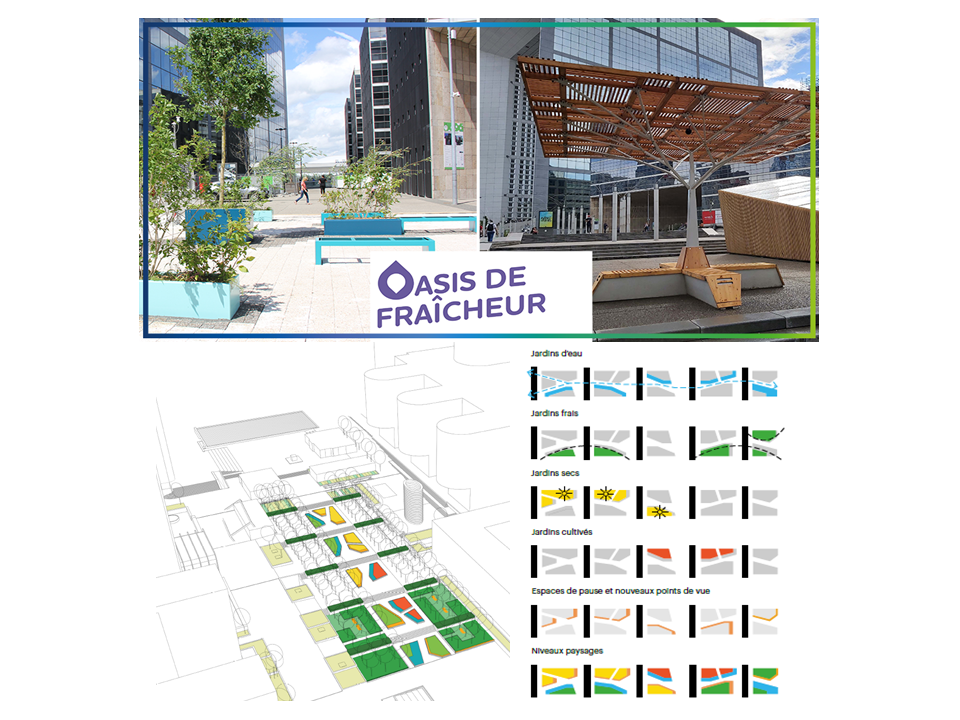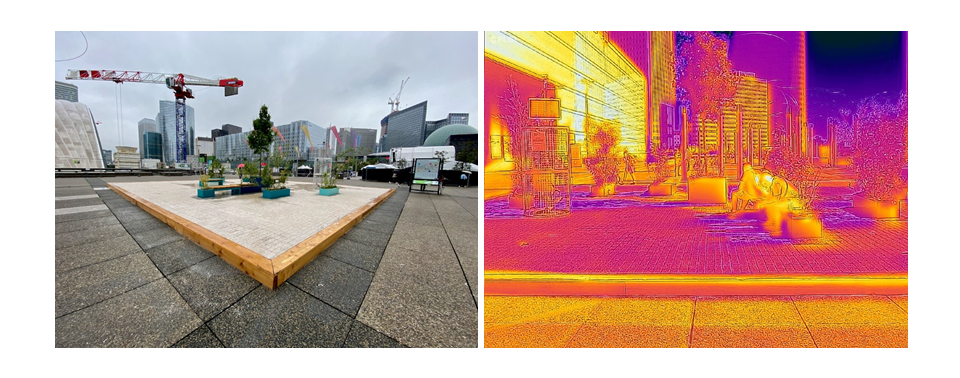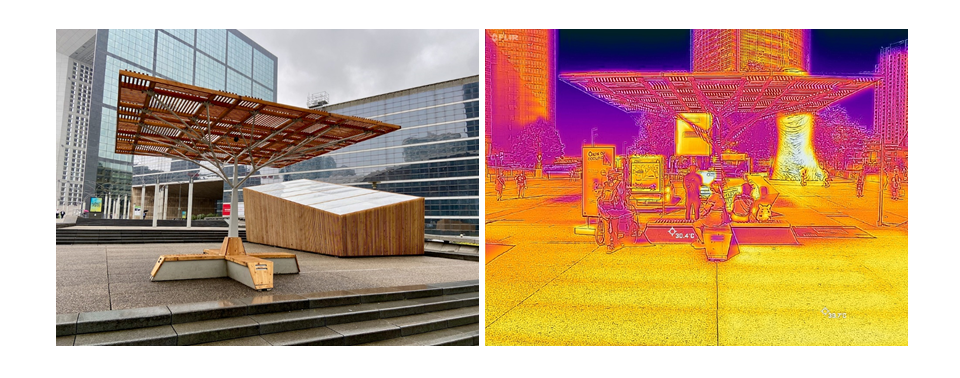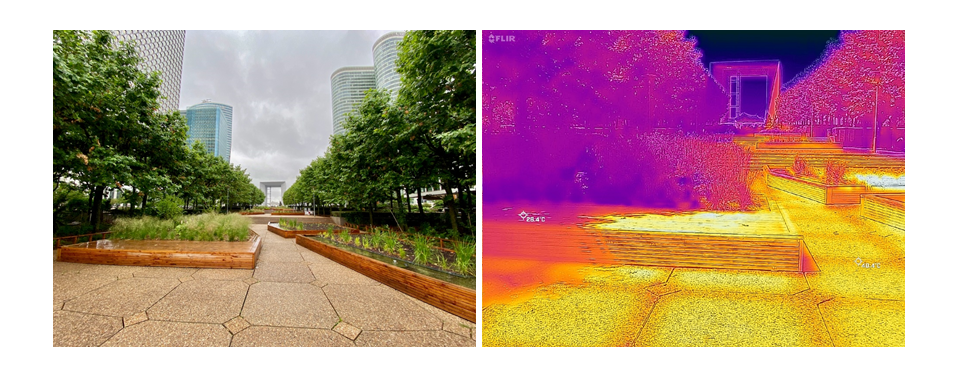Experimental sites – summer 2021
Published on August 31, 2021
This summer, we went to Paris La Défense to investigate three spatio-climatic devices in collaboration with Paris La Défense, Efficacity, Véolia, Université Gustave Eiffel and Engie. Efficacity and Paris La Défense have launched two experiments to refresh public spaces during this summer, also presented as “Oasis of freshness” (additional information: https://efficacity.com/experimentations-oasis-de_fraicheur/ or https: //parisladefense.com/). These include a “refreshing platform” from Seureca / Veolia and a “fresh island – skycooling” from Engie Solutions, placed on the forecourt near the Grande Arche of La Défense (Figure 1, top). In addition, we wanted to add to this campaign a third site, consisting of a landscaped sequence of gardens on slabs, called “Sequence Agam”. It was designed by Atelier Foïs and is located between the fontaine Agam Place and the Basse Place (Figure 1, bottom).
Mobile microclimate and ethnographic observations were carried out between July 18th and 22nd, 2021 between 11:00 a.m. and 6:30 p.m. for 5 consecutive days, juggling between the three sites. These observations complete the static measurements carried out by permanent stations during the test period. The stations are directly set up on the refreshing platform and the fresh island as well as on the square in between.

Figure 1: Experimental sites in Paris La Défense, summer 2021. Top : oasis of freshness (source : https://efficacity.com/experimentations-oasis-de_fraicheur/), bottom : Experimental garden « Séquence Agam », by Atelier Foïs (source : https://www.atelierfois.com/info.html)
1. Refreshing platform (Seureca) :
The platform measures 200 m2 on the ground and combines several cooling modes (Figure 2): porous paving stones which allow the rainwater, stored in a tank located in nearby technical rooms, to evaporate; and vegetated trays which retain rainwater and which are also watered from the tank. This device seeks to invite users to take a break in a place often perceived as hostile due to its mineral property. A weather station installed on-site makes it possible to adjust the rate of humidification of the paving stones and to trigger and stop the water demand according to the on-site conditions. This device was developed by Seureca in partnership with the societies Alkern and Vertuo.
We have conducted two measurement trajectories on this device. One begins at the metro exit, winds the device through the vegetated trays and urban furniture and ends at the Grande Arche. The second trajectory begins at the Grande Arche, crosses the device diagonally and continues on the square towards the fresh island, stopping under its shelter. This trip was imagined as the usual urban trajectory of a person discovering the two sites or working at La Défense.

Figure 2: left: Paris La Défense, refreshing platform, right: thermal photo with cooler areas in violet end hotter areas in yellow.
2. Fresh island – skycooling (Engie Solutions):
The fresh island has already been installed several times in Paris, especially in 2019. The cooling methods are twofold: i) the artificial canopy of 25 m2, carried by a metallic tree structure, produces shade below and around the device, ii) and the cooling benches equipped with a combined system of air / water exchangers and fans. Unlike the previous versions, connected to the cold-water network of the city of Paris, this installation introduces as a novelty the production of cold water on site in a closed circle. Therefore, the Skycooling panels developed by the Engie Lab Crigen research center in collaboration with Engie Solutions, covering the roof of the cube, allow the water to be cooled overnight using a radiative technique (Figure 3).
In addition to the trajectory including the two oases of freshness, several measurement points were investigated at the end of each cooling bench and at the interior corners in between. Therefore, the measurement points have been adapted according to the devices occupation.

Figure 3: left: Paris La Défense, fresh island – Skycooling, right: thermal photo with cooler areas in violet end hotter areas in yellow.
3. Experimental Garden (Atelier Foïs):
Located between Fontaine Agam Place and Basse Place, the landscape sequences of gardens were installed above ground in 2020 for a 3-year period in order to question the sustainable landscape adapted to the ground slab of La Défense (Figure 4). It is a series of experimental gardens that will allow landscapers and users to take ownership of the place while evaluating the chosen species and substrates, the applied maintenance techniques and practices (watering) and the proposed functions such as water, dry, fresh as well as cultivated.
The measurement trajectory crosses the garden from up to down, passing through tree-shaded areas and through the ground slab located outside the green space. Therefore, it is possible to reconstruct a longitudinal path in the middle of the various water, fresh, dry and cultivated gardens, or to reconstruct transects taking into account the outside climate conditions of the site.

Figure 4: left: Experimental gardens « Séquence Agam », between Fontaine Agam Place and Basse Place, Paris La Défense, right: thermal photo with cooler areas in violet end hotter areas in yellow.
Sites expérimentaux – été 2021
Cet été, nous sommes allés à Paris La Défense afin d’investiguer trois dispositifs spatio-climatiques en collaboration avec Paris La Défense, Efficacity, Véolia, Université Gustave Eiffel et Engie. Efficacity et Paris La Défense ont lancé deux expérimentations de rafraîchissement de l’espace public pendant la période estivale, également présentées comme « Oasis de fraîcheur » (informations supplémentaires : https://efficacity.com/experimentations-oasis-de_fraicheur/ ou https://parisladefense.com/). Il s’agit notamment d’une « estrade rafraîchissante » de Seureca/Veolia et d’un « îlot frais – skycooling » d’Engie Solutions, posés sur le parvis près de la grande arche de La Défense (Figure 1, en haut). De plus, nous avons souhaité joindre à cette campagne un troisième site consistant en une séquence paysagère de jardins sur dalle, appelée « Séquence Agam ». Ce jardin a été conçu par l’Atelier Foïs, et est situé entre la Place de la fontaine Agam et la Place Basse (Figure 1, en bas).
Des observations microclimatiques mobiles et ethnographiques ont été conduites entre le 18 et le 22 juillet 2021 entre 11h00 et 18h30 pendant 5 jours consécutifs, jonglant entre ces trois sites. Ces observations viennent en appui des mesures statiques réalisées par des stations permanentes durant la période d’essai. Les stations sont installées sur l’estrade et l’îlot eux-mêmes et sur le parvis entre ces deux oasis de fraîcheur.
1. Estrade rafraîchissante (Seureca) :
L’estrade mesure 200 m2 au sol et combine plusieurs modes de rafraîchissement (Figure 2) : des pavés poreux qui permettent d’évaporer l’eau de pluie stockée dans un réservoir situé dans des locaux techniques proches, et des bacs de végétation qui retiennent de l’eau de pluie et qui sont également arrosés avec l’eau du réservoir. Ce dispositif cherche à inviter les usagers à faire un temps de pause dans un lieu souvent perçu comme hostile par sa minéralité. Une station météo installée sur le dispositif permet de régler le taux d’humidification des pavés et de déclencher et arrêter la demande en eau en fonction des conditions mesurées sur place. Ce dispositif a été développé par Seureca en partenariat avec les sociétés Alkern et Vertuo.
Nous avons conduit deux trajets de mesures sur ce dispositif. Un trajet commence à la sortie du métro, serpente le dispositif à travers les bacs végétalisés et le mobilier urbain et se termine à la grande arche. Le deuxième trajet débute à la grande arche, traverse le dispositif en diagonale et continue sur le parvis vers l’îlot frais en s’arrêtant sous l’abri de ce dernier. Ce trajet a été imaginé comme trajectoire urbaine habituelle d’une personne découvrant les deux sites ou bien travaillant à La Défense.
2. Îlot frais – Skycooling (Engie Solutions) :
L’îlot frais a été déjà installé à plusieurs reprises à Paris, notamment en 2019. Les modes de rafraîchissement sont doubles : i) la canopée artificielle de 25 m2, portée par une structure arborescente, produit des zones ombragées en dessous et autour du dispositif, ii) et le banc rafraîchissant équipé d’un système combiné d’échangeurs air/eau et des ventilateurs. A l’inverse des versions précédentes, branchées sur le réseau eau froide de la ville de Paris, cette installation introduit comme nouveauté une production d’eau froide sur place en circuit fermé. Ainsi les panneaux Skycooling développés par le centre de recherche Engie Lab Crigen en collaboration avec Engie Solutions, couvrant la toiture du cube, permettent de refroidir l’eau pendant la nuit par une technique radiative (Figure 3).
En plus du trajet qui inclue les deux oasis de fraîcheur, plusieurs points de mesures ont été investigués à l’extrémité de chaque assise et aux coins intérieurs entre deux assises. Ainsi les points de mesures ont été adaptés en fonction de l’occupation du dispositif.
3. Jardins sur dalle (Atelier Foïs):
Situés entre la Place de la fontaine Agam et la Place Basse, ces jardins ont été installés hors sol en 2020 pour une durée de 3 ans afin de questionner le paysage durable et adapté à la dalle de La Défense (Figure 4). C’est une série des jardins expérimentaux qui vont permettre aux paysagistes et aux usagers de s’approprier le lieu toute en évaluant les espèces et les substrats choisis, les techniques et pratiques d’entretien appliquées (arrosage) et les fonctions proposées (milieux d’eau, sec, frais, cultivé).
Le trajet de mesures traverse le jardin de haut en bas en passant par les aires arborées et par la dalle située à l’extérieur de l’espace végétalisé. Ainsi, il est possible de reconstituer un parcours longitudinal au milieu des différents jardins d’eau, frais, secs et cultivés ou bien de reconstituer des parcours transversaux en prenant en compte les conditions climatiques extérieures du site.
Authors
Xenia Laffaille and Ignacio Requena